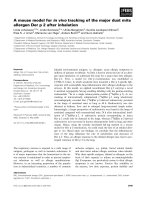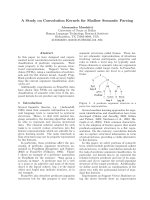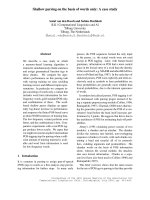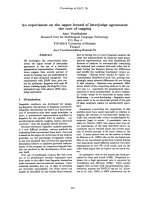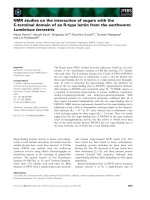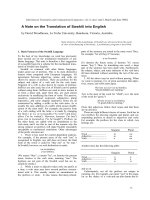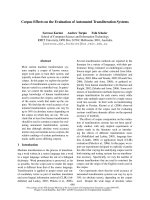Báo cáo khoa học: "Comparative study on the in vitro and in vivo properties of two bovine herpesvirus-5 reference strains" pptx
Bạn đang xem bản rút gọn của tài liệu. Xem và tải ngay bản đầy đủ của tài liệu tại đây (467.91 KB, 8 trang )
RESEARCH Open Access
Comparative study on the in vitro and in vivo
properties of two bovine herpesvirus-5 reference
strains
María F Ladelfa
1,3
, María P Del Médico Zajac
1
, Fiorella Kotsias
1,3
, Fernando Delgado
4
, Benoît Muylkens
2
,
Julien Thiry
2
, Etienne Thiry
2*
and Sonia A Romera
1,3
Abstract
Background: Bovine herpesvirus 5 (BoHV-5) is an alphaherpesvirus responsible for meningoencephalitis in young
cattle and it is antigenically and genetically related to bovine herpesvirus 1. BoHV-5 outbreaks are sporadic and
restricted in their geographical distribution, being mostly detected in the Southern hemisphere. The N569 and
A663 strains are prototypes of the “a” and “b” subtypes of BoHV-5, however, scarce information about their in vitro
and in vivo properties is currently available.
Methods: For the in vitro comparison between BoHV-5 A663 and N569 strains, viral growth kinetics, lysis and
infection plaque size assays were performed. Additionally, an experimental infection of cattle with BoHV-5 A663
and N569 strains was carried out. Viral excretion, development of neurological signs, presence of specific antibodies
in serum and nasal swabs and pres ence of latent BoHV-5 DNA in trigeminal ganglion, were analyzed.
Histopathological examination of samples belonging to inoculated animal s was also performed.
Results: The lytic capacity and the cell-to-cell spread was lower for the A663 strain compared to the N569 strain,
however, the production of total infectious viral particles was similar between both strains. Concerning the in vivo
properties, the A663 and N569 strains are able to induce similar degrees of pathogenicity in cattle.
Conclusions: Our results show that the A663 strain used in this study is less adapted to in vitro replication in
MDBK cells than the N569 strain and, although slight differences were observed, both strains are able to induce a
similar degree of virulence in the natural host.
Background
Bovine herpesvirus 5 (BoHV-5) is an alphaherpesvirus
associated with meningoencephalitis in young cattle and
it is antigenically and genetically related to bovine her-
pesvirus 1 (BoHV-1) [1-3]. BoHV-5 was former classi-
fied as a neuropathogenic variant of BoHV-1. In 1992,
data based on restriction site mapping of viral DNA
[4-6], cross-neutraliza tion tests, and monoclonal anti-
body reactivity [7,8], allowed the Internat ional Commit-
teeonTaxonomyofVirusestorecognizeBoHV-5asa
distinct virus from BoHV-1 [9].
Contrasting with the BoHV-1 worldwide distribution,
BoHV-5 outbreaks are sporadic and restricted in their
geographical distribution, being mostly detected in the
Southern hemisphere. The reasons for this particular
distribution are still undetermined. Sporadic cases of
BoHV-5-associated encephalitis have been detected in
Australia [10,11], North America [4,12] and Europe
[13,14]. Outbreaks are most commonly reported in Bra-
zil [15-17] and Argentina [18-20].
According to restriction endonuclease analysis, BoHV-
5 strains are classified into th ree subtypes [8,21]. Type
strains for subtypes “ a”, “b” and “non-a-non-b” ,arethe
Australian strain N569, the Argentinean strain A663
and Brazilian isolates, respectively. Despite the geogra-
phical proximity between Argentina and Brazil, most of
the Brazilian isolates studied belong to the “a ” subtype
* Correspondence:
2
Virology and Viral Diseases, Department of Infectious and Parasitic Diseases,
Faculty of Veterinary Medicine, University of Liège, Boulevard de Colonster,
20, B43b, B-4000 Liège, Belgium
Full list of author information is available at the end of the article
Ladelfa et al. Acta Veterinaria Scandinavica 2011, 53:37
/>© 2011 Ladel fa et al; licens ee BioMed Central Ltd. This is an Open Access article distributed under the terms of the Creative Commons
Attribution License (htt p://creativecommons.org/licenses /by/2.0), which permits unrestricted use, distribution, and reproduction in
any medium, provided the original work is properly cited.
[21]. This discrepancy could be attributed to the small
number of BoHV-5 isolates characterized to date in
Argentina and Brazil. Besides, the isolates examined to
date may not be actual representatives for the most pre-
valent viruses in Brazil, as well as A663 itself may not
be a typical representative of most Argentinean BoHV-5
isolates currently circulati ng in this country. In line with
this, recent analysis of Argentinean BoHV-5 i solates iso-
lated from 1982 to 2007 revealed that the “a” su btype is
the most prevalent in this country [22]. Further charac-
terization of recently isolated BoHV-5 field strains from
Argentina and Brazil will provide information about the
subtypes currently circulating in these countries.
BoHV-5 infection induces different degrees of severity
of neurological disease depending on both viral and host
factors. Viral genes and their encoded proteins involved
in the neurovirulence of alphaherpesviruses are classified
in three groups: enzymes involved in nuclei c acid meta-
bolism, factors that modulate the immune response and
viral glycoproteins (g). Regarding viral glycoproteins, a
role in the anterograde transport of gI, gE and Us9 was
suggested in the rabbit model [23,24]. Concerning host
factors, the age and immunological status of the animals
appear to be the most relevant ones [25].
Scarce in vitro studiestoassessthegrowthproper-
ties of N569 and A663 strains have been performed.
These studies allowed the identification of cell lines
susceptible to BoHV-5 [10] and the establishment of
growth curves [19]. Concerning in vivo properties,
some experimental inoculations with BoHV-5 N569
and A663 strains have been carried out [8,26-28]. In
these studies, neurological signs, such as bruxism,
depression, anorexia and muscle trembling, were
observed in calves infected with both BoHV-5 strains.
Although BoHV-5-induced encephalitis is usually fatal
in young animals, some experimentally infected calves
develop subclinical infection [25,29,30] or moderate
disease[27].However,uptonow,thein vivo studies
of N569 and A663 strains were independently per-
formed and carried out under different conditions. At
this point, a direct comparison of the pathogenecity of
these strains is difficult to make.
In this context, the aim of the present study is to
compa re the in vitro and in vivo properties of these two
BoHV-5 reference strains belonging to different
subtypes.
Materials and methods
Viruses and cell culture
The N569 BoHV-5 strain was isolated from a brain
sample after several intracerebral inoculations of calves
with brain tissue obtained from an outbreak of menin-
goencephalitis in calves reported in 1962 in Australia
[10]. T he A663 BoHV-5 strain was isolated from a case
of non purulent encephalitis in an outbreak among
calves in 1982 in Argentina [19].
N569 and A663 BoHV-5 strains were propag ated in
Madin Darby bovine kidney (MDBK) cells and viral
stocks were produced after infection of MDBK at a low
multiplicity of infection (MOI) as previously described
[31].
Viral growth kinetic
To perform one-step kinetics, MDBK monolayers grown
in 60 mm culture dishes w ere inoculated with BoHV-5
N569 or A663 at MOI 5. Cells were incubated at 4°C
for 2 h in order to synchronize virus adsorption. Then,
cells were incubated at 37°C for 2 h and treated with
low pH solution (40 mM citric acid, 10 mM KCl, 135
mM NaCl) for 2 min to inactivate the remaining extra-
cellular virus. Monolayers were rinsed with PBS, E-
MEM 2% FCS was added and the dishes were incubated
at 37°C. At 0; 3; 6; 12; 15; 18 and 24 h post infection
(hpi) the extracellular and total fractions were obtained.
These fractions were titrated twice on MDBK mono-
layers in duplicate and viral titres were calculated by the
Reed and Muench method [31]. Mean of viral titres
were compared by Mann-Whit ney no-parametric test,
P<0.05(SoftwareMedCalc
®
statistical software version
11.1.1.0).
Lysis and infection plaque size assays
MDBK monolayers grown in 12 wells culture plates
were inoculated with BoHV-5 N569 or A663 at tenfold
serial dilutions. After 2 h of incubation at 37°C, the
inocu lum was removed and 2 ml of carboxy methyl cel-
lulose (CMC) 1.5% FCS per well were added. Plates
were incubated at 37°C for 72 h.
For the lysis plaque size assay, cells were fixed with
10% formaldehyde for 10 min at room temperature,
stained with violet crystal (1% violet crystal, 10% ethanol
in PBS) for 20 min and washed in PBS. For each virus,
60 isolated and randomly selected lysis plaques were
observed with an optical microscope and photographed.
For the infection plaque s ize assay, cells were fixed
with 4% paraformaldehyde (PFA) for 10 min at room
temperature. After washing in PBS, cells were incubated
for 1 h at 37°C with an anti IBR-FIT-C conjug ated anti-
body (VMRD, Inc. Pullman, U.S.A) diluted in PBS and
then cells were washed twi ce in PBS. For each virus, 30
isolated and randomly selected infectious foci were
observed with a fluorescent microscope and
photographed.
The photographs were analyzed with ImageJ software
in order to calculate lysis and infection plaques surfaces.
Animal experimental design
Ten 3-month-old calves were housed in an experimental
unit two weeks before infection. Upon arrival and before
Ladelfa et al. Acta Veterinaria Scandinavica 2011, 53:37
/>Page 2 of 8
experimental infection, their naïve status for BoHV-1
and 5 exposures were verified by ELISA, seroneutraliza-
tion and lack of viral isolation from nasal swabs. Calves
were separated in 2 groups of four animals each and
one group of two animals (control group, uninfected
animals). The groups were strictly isolated f rom each
other during the course of the study in order to avoid
viral spread and contamination. Animal care and experi-
mental procedures were performed in accordance with
the requirements of the National Institute of Agricul-
tural Technology Ethics Committee (INTA, Argentina).
Two groups were infect ed by aerosolization with 3 ml
of E-MEM containing a total dose of 10
6.5
TCID
50
/ml
(1.5 ml in each nostril) of N569 or A663 BoHV-5
strains. Control group received 3 ml of E- MEM. Clinical
observation of respiratory and nervous signs, and rectal
temperature were recorded in an individual sheet for
each animal. Be tween days 35-37 post infection (pi) ani-
mals were sedated with acepromazine (Asedan, Holliday
Laboratories, San Isidro, Argentina) by intramuscular
route and then euthanized by a barbiturate overdose
(Euthanyle, Brouwer Laboratorie s, Ciudad Autónoma de
Buenos Aires, Argentina). One animal from the BoHV-5
A663 group developed severe neurological signs and
was euthanized at day 15 pi. For all animals, necropsy
was performed immediately after euthanasia. Transverse
sections from the cervical spinal cord, olfactory cortex,
frontal, parietal and occipital cortex, thalamus, mesence-
phalon, cerebellum, trigeminal ganglia and respiratory
tract tissues were collected. To perform histological
examination, the samples were fixed in 10% neutral buf-
fered formalin, prepared by routine methods for histol-
ogy, paraffin embedded, sectioned at 4 μmandstained
with hematoxylin and eosin. The histopathological CNS
alterations were interpreted as follows: +++: severe; ++:
moderate; +: slight; -: none.
Sampling procedure, serological and virological analysis
Blood samples were taken on the day of inoculation and
then weekly by jugular venipuncture to monitor anti-
body levels. Sera obtained after centrifugation were
stored at -20°C until analyzed. Serum antibo dies against
BoHV-1 and -5 were detected by ELISA and seroneutra-
lization [31].
Nasal secretions were collected inserting tampons in
the ventral meatus of the nasal cavity for 5 min (to
assure the absorption of nasal fluids potentially con-
taining viral particles into the tampon) and thereafter
immediately dipped in 5 ml E-MEM containing 5000
IU penicillin/ml, 2500 μg streptomycin/ml and 10 μg
amphotericin B/ml [31]. Tampons were centrifuged
and samples were stored at -80°C until used. Nasal
samples were taken daily from day 0 to 18 pi and
then two times per week until the end of the study.
Nasal swabs were inoculated immediately after collec-
tion onto MDBK cell monolayers: 0.1 ml of nasal
fluids was inoculated onto 96 well microtitre plates
and tenfold serial dilutions were tested in four wells.
Monolayers were inspected until cytopathic effect
appeared and virus titres were calculated by the Reed
and Muench method [32]. IgA antibodies in nasal
secretions were determined by ELISA as previously
described [27].
Detection of latent BoHV-5 DNA in trigeminal ganglion
Pieces of approximately 100 mg of trigeminal ganglion
were digested and total DNA extracted using the
QIAamp DNA Mini kit (Qiagen, Spain). In order to
examine the presence of viral DNA, a poly merase chain
reaction (PCR) that amplifies BoHV-5 gD gene was per-
formed [33]. PCR was also performed with a set of pri-
mers generating a 250 base pair fragment from the
bovine gly ceraldehyde-3-phosphate dehydrogenase gene
(GAPDH), selected as bovine housekeeping gene. The
primers were designated as GAPDH- Fow (5’-GCA TCG
TGG AGG GAC TTA TGA) and GAPDH-Rev (5’-GGG
CCA TCC ACA GTC TTC TG).
Results
In vitro characterization
With the aim of performing an in vitro comparison
between N569 and A663 BoHV-5 strains, their growth
properties, lysis and infection plaque size were assessed.
The one-step growth kinetics curves profiles for the
N569 and A663 strains of BoHV-5 were established.
Total fractions curves showed similar profiles and the
amount of infectious vi rus produced was also similar
between both strains at each time assayed (Figure 1A).
Significant differences between A663 and N569 viral
titres in their total fractions at each time assayed were
not found. Maximum titres were obtained at 24 (10
6.8
TCID
50
/ml) and 18 (10
7.0
TCID
50
/ml) hpi for N569 and
A663, respectively.
As shown in Figure 1B, the release of infectiv e viral
particles to the extracellular media was first detected for
A663 strain (at 6 hpi). H owever, the viral titre reached
by this strain from 15 to 24 hpi was slightly lower than
the titre reached by N 569 strain. Although significant
differences between N569 and A663 viral titres were
observed at 15 and 18 hpi, at the end of the assay (24
hpi) both strains showed similar viral titres in their
extracellular fractions.
In order to study the lytic capacity of both BoHV-5
strains, the lysis plaque size assay was performed. This
parameter contrib utes to the in vitro characterization of
viruses because it represents a direct measure of viral
lytic potential and an indirect measure of viral cell-to-
cell spread.
Ladelfa et al. Acta Veterinaria Scandinavica 2011, 53:37
/>Page 3 of 8
Thecomparisonofthelysisplaquesizeafterthe
inoculation of MDBK monolayers with the N569 and
A663 strains, shown a sharp difference, being the pla-
ques generated by the A663 strain 90% smaller than
those generated by the N569 strain (Figure 2). This
result is in agreement with the lower viral titres
observed in the extracellular fraction of the one-step
growth kinetics of the A663 strain in comparison with
those of the N569 strain.
To further analyze the cell-to-cell spread of the N569
and A663 strains, the infection plaque size assay was
performed. This assay takes into consideration the cells
lysed by the virus and also the infected cells expressing
viral antigens on their surface, being therefore an appro-
priate tool for studying cell-to-cell dissemination.
The comparison between the infection plaques gener-
ated by N569 and A663 strains showed a sharp differ-
ence, being the plaques generated by the A663 strain
80% smaller than those generated by the N569 strain
(Figure 3).
In vivo characterization
In order to perform an in vivo comparative study of the
reference BoHV-5 strains, two groups of 4 calves were
infected with N569 (subtype “a”)orA663(subtype“b” )
strains. A mock infected group of two animals was
included (control group).
After intranasal infection, both groups showed a simi-
lar time pe riod of viral excretion (14 days). Thr ee out of
four animals infected with N569 strain presented viral
particles in nasal swabs, one of them showing an inter-
mittent profile of viral excretion (Table 1). All the ani-
mals infected with A663 strain shed virus, three of them
excreted during 5-13 days and the remaining one
showed intermittent excretion (Table 1). The profiles of
viral shedding were similar between both groups in the
studied period. Control animals did not excrete virus
during the studied period.
Clinical signs associated with BoHV-5 infection were
observed in one A663 infected calf. This animal showed
breathing difficulties and a slight ptyalism at day 11 pi.
Nervous signs started day 12 pi and were characterized by
bruxism, ptyalism, muscular tremor, circular movements,
ataxia and seizure-like episodes. At day 15 pi this animal
was euthanized according to ethical considerations. None
0
1
2
3
4
5
6
7
8
9
0 3 6 9 12 15 18 21 24
hpi
Log TCID 50/ml
N569 total
A663 total
A
0
1
2
3
4
5
6
7
8
9
0 3 6 9 12 15 18 21 24
hpi
Log TCID 50/ml
N569 extra
A663 extra
B
*
*
*
Figure 1 One-st ep growth kinetics of bovine herpesvirus-5
N569 and A663 strains (MOI 5). A: total fraction viral titres. B:
extracellular fraction viral titres. Viral titres are expresed as Log
10
TCID
50
/ml. * N569 and A663 are significantly different (Mann-
Whitney, P < 0.05).
A
B
100
9
0
20
40
60
80
100
120
140
160
% Lysis Plaque Area
N569
A663
C
Figure 2 Lysis plaques generated by bovine herpesvirus-5
A663 (A) and N569 (B) strains. Magnification Obj. 40×. C: Size rate
between both strains. The N569 mean area was established as
100%. Error bars represent standard deviation. N569 and A663 are
significantly different (Mann-Whitney, P < 0.01).
A
B
100
18.52
0
20
40
60
80
100
120
140
% Infection plaque Area
N569
A663
C
Figure 3 Infection plaques generated by bovine herpesvirus-5
A663 (A) and N569 (B) strains. Magnification Obj. 40×. C: Size rate
between both strains. The N569 mean area was established as
100%. Error bars represent standard deviation. N569 and A663 are
significantly different (Mann-Whitney, P < 0.01).
Ladelfa et al. Acta Veterinaria Scandinavica 2011, 53:37
/>Page 4 of 8
of the animals infected with BoHV-5 N569 strain devel-
oped nervous signs during the studied period. At days 35-
36 pi the surviving animals were sacrificed and necropsy
was performed.
Histopathological examination of samples belonging to
BoHV-5 N569 and A663 groups revealed the presence
of severe lesions in the CNS associated with BoHV-5
infection in two out of four animals in each group.
These animals presented non suppurative meningoence-
phalitis in the olfactory cortex, frontal, parietal and occi-
pital cortex, thalamus, mesencephalon and cerebellum.
Focal gliosis was also found. Mild infiltration by macro-
phages in the mesencephalon, thalamus, cerebellum and
spinal cord were observed. T he other two animals from
BoHV-5 A663 strain group showed moderate or slight
lesions in all sect ions examined meanwhile the other
two animals infected with N569 did not show significant
alterations in the CNS (Table 2).
Next, the establishment of latency of both BoHV-5
strains was examined. In order to test the presence of
latent BoHV-5 DNA, PCR a ssays were performed using
samples from trigeminal ga nglia dissected after euthana-
sia. Viral DNA was detected in all animals from A663
group and in two animals from N569 group (Table 2).
In addition, trigeminal ganglia were assessed for induc-
tion of cy topathic effect in susceptible cells. Since no
cytopathic effect was developed in the cultures, we con-
cluded that the positive PCR results w ere due to the
presence of latent viral genomes.
With a view to evaluating seroconversion specifically
raised against BoHV-5 after the experimental infection,
serum antibodies and mucosal IgA were analysed.
Serum antibodies either measured by ELISA or by SN
assay were detected in seven out of eight BoHV-5
infected animals. Moreover, we d etected nasal IgA in
five out of eight infected animals (Table 2).
Discussion
TherealprevalenceofBoHV-5isunknownbecause
outbreaks are sporadic and routine serologic tests do
Table 1 Viral titres shedding after experimental infection of calves (n = 8) with N569 and A663 strains of bovine
herpesvirus (BoHV)-5
Grupo Animal no. Days post infection
2 3 4 5 6 7 8 9 101112131415
BoHV-5 N569 628 Nd Nd Nd Nd Nd 2 Nd 5 Nd 3.5 3.5 3.5 3.3 2.5
191 Nd Nd Nd Nd Nd Nd Nd Nd Nd Nd Nd Nd Nd Nd
199 1.6 4.3 Nd Nd 3.3 Nd Nd Nd Nd Nd Nd Nd Nd Nd
636 2.6 Nd 5 5.3 Nd 4.3 6 3 4.5 Nd 3 Nd Nd Nd
BoHV-5 A663 254 3 2.3 5 4.5 4.5 5 3.5 Nd 3.5 1.6 3.3 Nd Nd 2
619 3.6 5.3 5.5 5.5 5 NdNdNdNdNdNdNdNdNd
192 3.5 4 4.6 5.3 6 6.5 6.3 5 5.3 3.5 3.5 2 1.6 Nd
185 Nd Nd 2.5 Nd Nd Nd Nd Nd Nd 2.3 2 Nd Nd Nd
Nd: Non detected
Titres are expressed as log TCID50/ml of nasal secretions. For each animal, the peak titer of viral excretion is highlighted in bold.
Table 2 Data obtained from calves (n = 8) experimentally inoculated with A663 and N569 strains of bovine
herpesvirus (BoHV) 5
Group Animal
no.
Viral excretion* (peak
titre)
Severity of histopathological changes
(mean)**
DNA in
TG
SN Abs titre(log)
***
Nasal
IgA
BoHV-5
N569
636 2-12 (6) +++ + 1.5 +
628 7-15 (5) ++ + 1.05 -
199 Intermittent (4.3) - - 1.5 +
191 - - - - -
BoHV-5
A663
192 2-12 (6.5) +++ + 0.9**** -
619 2-6 (5.5) +++ + 0.9 +
185 Intermittent (2.3) + + 0.9 +
254 2-12 (6.3) + + 0.9 +
*Viral excretion is expressed as log TCID
50
/ml. **Score based on the presence of the following CNS histopathological alterations: vascular alteration, inflammation,
focal gliosis, infiltration by macrophages and malacia. References: +++: severe; ++: moderate; +: slight; -:negative. ***Serum neutralizing (SN) antibodies (Abs) at
day 34 post infection (pi). ****Animal 192 was euthanized 15 days pi, the titre of SN Abs corresponds to this date.
Ladelfa et al. Acta Veterinaria Scandinavica 2011, 53:37
/>Page 5 of 8
not discriminate between antibodies against BoHV-5
and BoHV-1. Due to that, BoHV-5 sanitary and eco-
nomic i mpact may be underestimated. This, in a ddition
to the scarce information available on BoHV-5 biology,
has prompted the present study.
The in vitro characterization performed here suggests
that the A663 strain (BoHV-5 subtype “b”) possesses
diminished capacities concerning cell lysis and cell-to-
cell spread in comparison with the N569 strain (BoHV-
5subtype“ a” ). In additi on, the in vivo properties of
A663 and N569 were analyzed and, as a result, we
observed that both BoHV-5 strains induced a similar
degree of virulence in cattle.
Regarding the in vitro characterization, the results
obtained from the one-step growth kinetic showed that
the production of total infectious viral particles was
similar between both BoHV-5 strains. However, the
release of infectious viral particles to the extracellular
mediawaslowerfortheA663strain.Theone-step
growth kinetic was performed at high MOI, thus, all
cell s were infected and cell-to-cell spread was not b eing
evaluated. Hence, the lower release o f A663 infectious
viral particles to the extracellular media suggested a
lower lytic capacity for this strain. This suggestion was
directly confirmed by the lysis plaque size assay, which
showed that lysis plaques generated by A663 were 90%
smaller than those generated by N569. Indeed, this dra-
matic difference led us to suggest that the A663 strain
has a less effective cell-to-cell spread in comparison
with N569. In this respect, multiple-steps gro wth kinetic
(performed at low MOI) showedtheviraltitresinboth
extracellular and total fractions were larger for N569
than for A663, supporting the contribution of cell-to-
cell spread to the lysis plaque area reduction observed
for the A663 strain (data not shown). To further assess
this, the infection plaque size assay was performed and
showed that A663 plaques were 80% smaller than those
generated by N569 strain. In this context, we concluded
that both lytic capacity and cell-to-cell spread are dimin-
ished in the A663 strain in comparison with N569. The
fact that A663 and N569 reach the same viral titres in
their total fractions in the one-step growth kinetics
(from 3 to 24 hpi) indicates that viral particles are
equally produced by both strains, however, A663 viral
particles could be retained for longer times inside the
cell due to their difficulties in cell-to-cell spread and cell
lysis.
Some aspects of the in vitro viral replication discussed
here could have some r elevance in vivo, for example: i)
in vitro total production of infectious virus could be
related with in vivo levels of viral excretion, or ii) in
vitro cell-to-cell spread could have consequences on
viral dissemination and infection of different animal tis-
sues, or iii) the lytic capacity could be associated with
the level of tissues damage and therefore with the clini-
cal signs observed after viral infection. All these correla-
tions could help understandi ng the fact that “b” subtype
of BoHV-5 has only been reported in Argentina [21,34]
and that it seems to have disappeared since it has not
been found circulating during the last years [22]. As
suggested by our in vitro results, A663 strain could have
diminished capacities to be maintained in the cattle
population, in contrast with “ a” subtypes of BoHV-5,
which circulation among Argentinean cattle herds have
been recently reported for first time [22].
The differences observed in the lysis and the infection
plaque sizes between both BoHV-5 stra ins are larger
tha n expected and h ave not been reported for wild type
strains of the same alphaherpesvirus previously. Despite
the fact that the viruses used to perform these assays
had the same number of cell culture passages (n = 8),
thepreviouspassagestothisexperienceontheoriginal
viral stocks were unknown. In our work, passage 8 o f
N569 strain was obtained after successive passages in
cell culture from virus excreted by an animal infected
with a N569 virus of unknown, and thus high, number
of passages. For this strain, no difference in l ysis plaque
size was observed between passage 8 and the virus o f
high number of pas sages used t o infect the bovine (data
not shown). Conce rning A663 strain, passage 8 of A663
strain was also obtained after successive passages in cell
culture from virus secrete d by an animal infected with
this strain, but in this case, the strain used to infect the
animal had a low number of passages. Contrary to
N569, a sharp difference between A663 passage 8 and
A663 of high number of passages was observed in lysis
plaque size, being those caused by A663 passage 8
much smaller. This indicates that plaque size increased
with the number of passages in cell culture of the non-
adapted to cell culture A663 strain (data not shown).
Taking all this into consideration, we are not able to
exclude differences between both strains strictly due to
cell culture adaptation. Additionally, the genetic back-
ground of N569 and A663 strains is unknown and we
are not able to rule out the possibility of genomic differ-
ences having an impact on the in vitro behavior of both
BoHV-5 strains.
Concerning the in vivo characterization, in spite of the
in vitro differences discussed above, we observed that
both BoHV-5 strains induced a similar degree of viru-
lence in cattle. Almost all animals infected with the
N569 or A663 strains showed moderate to high levels of
viral excretion confirming the virulence of the viruses
used. Individual susceptibility or technical problems dur-
ing the viral inoculation could account for the lack of
infection of the animal 191 from the N569 group.
Only one animal i nfected with A663 strain developed
clinical signs associated with BoHV-5 infection. This
Ladelfa et al. Acta Veterinaria Scandinavica 2011, 53:37
/>Page 6 of 8
difficulty in reproducing clinical encephalitis in BoHV-
5 infected animals was also faced by others [29,35].
Indeed, BoHV-5 infection could induce different
degrees of disease. In this respect, Meyer et al. [26],
infected 3-month-old calves with N569 B oHV-5 strain
and the animals developed severe neurological signs.
Additionally, 6 to 8-month-old animals experimentally
infected with the A663 strain developed a moderate
BoHV-5-induced neurological disease [27]. In other
studies, experimental infections in 4 to 6-month-old
calves with BoHV-5 TX74 and EC-1 field isolates
[25,29] and Brazilian isolate SV-507 [30], have been
performed without subsequent development of neuro-
logical symptoms, although histopathological changes
in the CNS were observed. In accordance with these
studies, we did not observe neurological signs in most
of the infecte d animals but histopathological examina-
tion of CNS samples eviden ced the development of
BoHV-5-associated encephalitis. Because the age of the
animals and the viral dose used in this study were
similar to those of previous studies in which clinical
signs were observed [26,27], the lack of neurological
signs reported here could be due to the individual
immunological status of cattle.
In addition, in agreement with results presented else-
where [36], latency was detected in all the animals
infected with A663 strain and two out of four animals
infected with N569. The negative result obtained f rom
trigeminal ganglion bel onging to animal 199 could be
due to technical problems with conservation and/or pro-
cessing of the sample. In the case of animal 191, as dis-
cussed above, the reason could have been the lack of
infection, as all the other parameters assayed were also
negative for this animal.
At this point, we could suggest that although the
development of neurological signs is not always achieved
under experimental infection with BoHV-5, presence of
lesions in the CNS and establishment of latency are
more frequently observed.
Finally, we showed that four out of four and three out
of four animals seroconverted after infection with A663
and N569 BoHV-5 strains, respectively. In addition,
three out of four and two out of four animals infected
with A663 and N569, respectively, presented IgA muco-
sal antibodies. This constitutes the fi rst report of IgA in
nasal secretions of animals infect ed with BoHV-5 and is
in agreement with previous reports showing induction
of nasal IgA in calves after i nfection with different
BoHV-1 strains [37]. Concerning animals 628 and 192,
the lack of IgA detection could be due to the sensitivity
of the ELISA test available. In the case of animal 191, as
dis cussed above, the reason coul d have been the lack of
infection.
Conclusions
The in vitro and in vivo properties of two strains of
BoHV-5 belonging to different subtypes were studied.
Our results show that the A663 strain used in this study
is less adapted to in vitro replicationinMDBKcells
than the N569 strain and, although slight differences
were observed, bot h strains are able to induce a similar
degree of virulence in the natural host. These results
also highlight the importance of considering viral in
vitro adaptation previous to study in vivo properties and
draw general conclusions about the biology of BoH V-5.
To study the plausible differences in virulence associated
to BoHV-5 subtypes, we think it would be suitable to
use BoHV-5 field isolates without previous adaptation to
cell culture inste ad of viral strains with unknown his-
tory. Taking all this into consideration, further research
should be done in order to better understand the biol-
ogy of BoHV-5 and the relevance of its subtypes.
Acknowledgements and Funding
Dr M. Studdert, University of Melbourne, Australia is thanked for providing
the N569 BoHV-5 strain. The authors are grateful to Diego Soraire and Javier
Leiva for their dedication and care of the calves used in the experiments.
This study was financially supported by the Agencia Nacional de Promoción
Científica y Tecnológica (ANPyCT), Ministerio de Ciencia, Tecnología e
Innovación Productiva, Argentina 396 (BID-PICT N°1433) and FNRS-CONICET
(Res. N° 1542/06).
Author details
1
Virology Institute, Veterinary and Agricultural Science Research Centre
(CICVyA), National Institute of Agricultural Technology (INTA), N. Repeto y
Los Reseros S/N, CC25 (B1712WAA), Castelar, Buenos Aires, Argentina.
2
Virology and Viral Diseases, Department of Infectious and Parasitic Diseases,
Faculty of Veterinary Medicine, University of Liège, Boulevard de Colonster,
20, B43b, B-4000 Liège, Belgium.
3
Consejo Nacional de Investigaciones
Científicas y Tecnológicas (CONICET), Rivadavia 1917 (C1033AAJ), Ciudad
Autónoma de Buenos Aires, Argentina.
4
Pathobiology Institute, Veterinary
and Agricultural Science Research Centre (CICVyA), National Institute of
Agricultural Technology (INTA), N. Repeto y Los Reseros S/N, CC25
(B1712WAA), Castelar, Buenos Aires, Argentina.
Authors’ contributions
MFL and SAR designed the experiments, analysed the data and drafted the
manuscript. MFL, MPDMZ, FK and SAR, performed the experiments. BM, JT
and ET participated in the in vitro characterization studies and interpretation
of data. FD carried out the histopathological analysis of the samples. All
authors read and approved the final manuscript.
Competing interests
The authors declare that they have no competing interests.
Received: 1 February 2011 Accepted: 8 June 2011
Published: 8 June 2011
References
1. Delhon G, Moraes MP, Lu Z, Afonso CL, Flores EF, Weiblen R, Kutish GF,
Rock DL: Genome of bovine herpesvirus 5. J Virol 2003, 77:10339-10347.
2. Thiry J, Tempesta M, Camero M, Tarsitano E, Bellacicco AL, Thiry E,
Buonavoglia C: A live attenuated glycoprotein E negative bovine
herpesvirus 1 vaccine induces a partial cross-protection against caprine
herpesvirus 1 infection in goats. Vet Microbiol 2006, 113:303-308.
3. Del Médico Zajac MP, Ladelfa MF, Kotsias F, Muylkens B, Thiry J, Thiry E,
Romera SA: Biology of bovine herpesvirus 5. Vet J 2010, 184:138-45.
Ladelfa et al. Acta Veterinaria Scandinavica 2011, 53:37
/>Page 7 of 8
4. d’Offay JM, Mock RE, Fulton RW: Isolation and characterization of
encephalitic bovine herpesvirus type 1 isolates from cattle in North
America. Am J Vet Res 1993, 54:534-539.
5. Engels M, Giuliani C, Wild P, Beck TM, Loepfe E, Wyler R: The genome of
bovine herpesvirus 1 (BHV-1) strains exhibiting a neuropathogenic
potential compared to known BHV-1 strains by restriction site mapping
and cross-hybridization. Virus Res 1986, 6:57-73.
6. Whetstone CA, Seal BS, Miller JM: Variability occurs in the inverted repeat
region of genomic DNA from bovine herpesvirus 1 respiratory, genital
and bovine herpesvirus 5 encephalitic isolates. Vet Microbiol 1993,
38:181-189.
7. Collins JK, Ayers VK, Whetstone CA, van Drunen Little-van den Hurk S:
Antigenic differences between the major glycoproteins of bovine
herpesvirus type 1.1 and bovine encephalitis herpesvirus type 1.3. J Gen
Virol 1993, 74:509-1517.
8. Metzler AE, Schudel AA, Engels M: Bovine herpesvirus 1: molecular and
antigenic characteristics of variant viruses isolated from calves with
neurological disease. Arch Virol 1986, 87:205-217.
9. Roizman B, Desrosiers RC, Fleckenstein B, Lopez C, Minson AC, Studdert MJ:
The family Herpesviridae: an update. Arch Virol 1992, 123:425-449.
10. French AL: A specific virus encephalitis in calves: isolation and
characterization of the casual agent. Aust Vet J 1962, 38:216-221.
11. Johnston LAY, Simmons GC, McGavin MD: A viral meningoencephalitis in
calves. Aust Vet J 1962, 38:207-215.
12. Reed DE, Bicknell EJ, Bury RJ: Systemic form of infectious bovine
rhinotracheitis in young calves. J Am Vet Med Ass 1973, 163:753-755.
13. Bartha A, Hajdu G, Aldasy P, Paczolay G: Occurrence of encephalitis
caused by infectious bovine rhinotracheitis virus in calves in Hungary.
Acta Vet Acad Sci Hung 1969, 19:145-151.
14. Moretti B, Orfei Z, Mondino G, Persechino A: Infectious bovine
rhinotracheitis, clinical observations and isolation of virus [in Italian]. Vet
Italiana 1964, 15:676-702.
15. Riet-Correa F, Vidor T, Schild AL, Mendez MC: Meningoencephalitis and
cerebral cortex necrosis in cattle caused by bovine herpes virus-1 [in
Spanish]. Pesq Vet Bras 1989, 9:13-16.
16. Riet-Correa G, Dutra Duarte M, Barbosa JD, Chaves Oliveira CM, Duarte
Cerqueira V, de Farias Brito M, Riet-Correa F: Meningoencephalitis and
poliencefalomalacia caused by bovine herpesvirus-5 in the State of Pará
[in Spanish]. Pesq Vet Bras 2006, 26:44-46.
17. Salvador JC, Lemos RAA, Riet-Correa F, Roehe PM, Osorio AR:
Meningoencephalitis in cattle caused by bovine herpesvirus-5 in Mato
Grosso do Sul and Sao Paulo [in Spanish]. Pesq Vet Bras 1998,
18:75-82.
18. Carrillo BJ, Ambrogi A, Schudel AA, Vazquez M, Dahme E, Pospischil A:
Meningoencephalitis caused by IBR virus in calves in Argentina. Zentralbl
Veterinarmed B 1983, 30:327-332.
19. Schudel AA, Carrillo BJ, Wyler R, Metzler AE: Infections of calves with
antigenic variants of bovine herpesvirus type 1 (BHV-1) and neurological
disease. J Vet Med B 1986, 33:303-310.
20. Perez SE, Vagnozzi A, Sur JH, Odriozola E, Campero CM, Odeón AC:
Retrospective analysis of cases with a diagnosis of cerebrocortical
necrosis and its relation to bovine herpesvirus type 5 [in Spanish]. Rev
Arg Microbiol 2003, 35:69-73.
21. D’Arce RC, Almeida RS, Silva TC, Franco AC, Spilki F, Roehe PM, Arns CW:
Restriction endonuclease and monoclonal antibody analysis of Brazilian
isolates of bovine herpesviruses types 1 and 5. Vet Microbiol 2002,
88:315-324.
22. Maidana SS, Ladelfa MF, Perez SE, Lomonaco PM, Del Medico Zajac,
Odeón A, Blanco Viera J, Combessies G, Fondevila N, Palacios M, Thiry J,
Muylkens B, Thiry E, Romera SA: Characterization of BoHV-5 field strains
circulation and report of transient specific subtype of bovine
herpesvirus 5 in Argentina. BMC Vet Res 2011, 7:8.
23. Chowdhury SI, Lee BJ, Ozkul A, Weiss ML: Bovine herpesvirus 5
glycoprotein E is important for neuroinvasiveness and neurovirulence in
the olfactory pathway of the rabbit. J Virol 2000, 74:2094-2106.
24. Chowdhury SI, Onderci M, Bhattacharjee PS, Al-Mubarak A, Weiss ML,
Zhou Y: Bovine herpesvirus 5 (BHV-5) Us9 is essential for BHV-5
neuropathogenesis. J Virol 2002, 76:3839-3851.
25. Ashbaugh SE, Thompson KE, Belknap EB, Schultheiss PC, Chowdhury S,
Collins JK: Specific detection of shedding and latency of bovine
herpesvirus 1 and 5 using a nested polymerase chain reaction. J Vet
Diagn Invest 1997, 9:387-394.
26. Meyer G, Lemaire M, Ros C, Belak K, Gabriel A, Cassart D, Coignoul F,
Belak S, Thiry E: Comparative pathogenesis of acute and latent infections
of calves with bovine herpesvirus types 1 and 5. Arch Virol 2001,
146:633-652.
27. Del Médico Zajac MP, Puntel M, Zamorano P, Sadir AM, Romera SA: BHV-1
vaccine induces cross-protection against BHV-5 disease in cattle. Res Vet
Sci 2006, 81:327-334.
28. Bagust TJ: Comparison of the biological, biophysical and antigenic
properties of four strains of infectious bovine rhinotracheitis herpesvirus.
J Comp Pathol 1972, 82:365-74.
29. Cascio KE, Belknap EB, Schultheiss PC, Ames AD, Collins JK: Encephalitis
induced by bovine herpesvirus 5 and protection by prior vaccination or
infection with bovine herpesvirus 1. J Vet Diagn Invest 1999, 11:134-139.
30. Vogel FS, Caron L, Flores EF, Weiblen R, Winkelmann ER, Mayer SV,
Bastos RG: Distribution of bovine herpesvirus type 5 DNA in the central
nervous systems of latently, experimentally infected calves. J Clin
Microbiol
2003, 41:4512-4520.
31. Romera SA, Hilgers LA, Puntel M, Zamorano PI, Alcon VL, Dus Santos MJ,
Blanco Viera J, Borca MV, Sadir AM: Adjuvant effects of sulfolipo-
cyclodextrin in a squalane-in-water and water-in-mineral oil emulsions
for BHV-1 vaccines in cattle. Vaccine 2000, 19:132-41.
32. Reed CJ, Muench HA: A simple method of estimating fifty per cent end
points. Am J Hyg 1938, 27:493.
33. Alegre M, Nanni M, Fondevila N: Development of a multiplex polymerase
chain reaction for the differentiation of bovine herpesvirus-1 and -5. J
Vet Med B Infect Dis Vet Public Health 2001, 48:613-21.
34. Esteves PA, Dellagostin OA, Pinto LS, Silva AD, Spilki FR, Ciacci-Zanella JR,
Hübner SO, Puentes R, Maisonnave J, Franco AC, Rijsewijk FA, Batista HB,
Teixeira TF, Dezen D, Oliveira AP, David C, Arns CW, Roehe PM:
Phylogenetic comparison of the carboxy-terminal region of glycoprotein
C (gC) of bovine herpesviruses (BoHV) 1.1, 1.2 and 5 from South
America (SA). Virus Res 2008, 131:16-22.
35. Bratanich AC, Sardi SI, Smitsaart EN, Schudel AA: Comparative studies of
BHV-1 variants by in vivo-in vitro tests. Zentralbl Veterinarmed B 1991,
38:41-48.
36. Winkler MT, Doster A, Jones C: Persistence and reactivation of bovine
herpesvirus 1 in the tonsils of latently infected calves. J Virol 2000,
74:5337-46.
37. Madic J, Magdalena J, Quak J, van Oirschot JT: Isotype-specific antibody
responses in sera and mucosal secretions of calves experimentally
infected with bovine herpesvirus 1. Vet Immunol Immunopathol 1995,
46:267-83.
doi:10.1186/1751-0147-53-37
Cite this article as: Ladelfa et al.: Comparative study on the in vitro and
in vivo properties of two bovine herpesvirus-5 reference strains. Acta
Veterinaria Scandinavica 2011 53:37.
Submit your next manuscript to BioMed Central
and take full advantage of:
• Convenient online submission
• Thorough peer review
• No space constraints or color figure charges
• Immediate publication on acceptance
• Inclusion in PubMed, CAS, Scopus and Google Scholar
• Research which is freely available for redistribution
Submit your manuscript at
www.biomedcentral.com/submit
Ladelfa et al. Acta Veterinaria Scandinavica 2011, 53:37
/>Page 8 of 8


